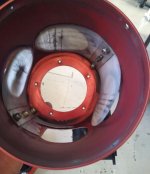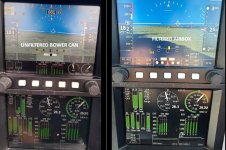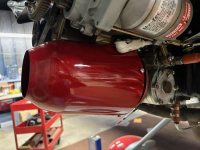Van's Air Force
You are using an out of date browser. It may not display this or other websites correctly.
You should upgrade or use an alternative browser.
You should upgrade or use an alternative browser.
Ram air in the rain ?
- Thread starter Weta
- Start date
Richard Connell
Well Known Member
It’s not a problem while the engine is running - within reason. If it’s ingesting so much water that your engine doesn’t like it then that’s likely the least of your problems.
Depending on its orientation at rest you may need to drill a small drain hole so the intake doesn’t fill up with standing water while the aircraft is parked. I doubt that’s an issue tho even for a TD RV7.
On my non ram air horizontal induction RV7 I had a small drain hole in the intake at the low point just ahead of the throttle body. But that cowl inlet sees a lot more rain parked than yours.
Depending on its orientation at rest you may need to drill a small drain hole so the intake doesn’t fill up with standing water while the aircraft is parked. I doubt that’s an issue tho even for a TD RV7.
On my non ram air horizontal induction RV7 I had a small drain hole in the intake at the low point just ahead of the throttle body. But that cowl inlet sees a lot more rain parked than yours.
I’ve recently finished my RV7. I installed the Rod bower ram air kit. Works great. However it didn’t occur to me at the time, is rain a problem? . Does anyone have experience with ram air in the rain ?. Should I drill a drain hole ?
If concerned, close the butterfly so the air is sourced is from inside the lower cowl.
BTW, an operational note for folks with a Bower....if one of the reeds is broken or does fit properly, the ram air is seriously pressurizing the lower cowl space, The result is a loss of deltaP for cooling.
This one had a missing reed and two which didn't seal.

...and the wrong kind of nuts holding it togetherIf concerned, close the butterfly so the air is sourced is from inside the lower cowl.
BTW, an operational note for folks with a Bower....if one of the reeds is broken or does fit properly, the ram air is seriously pressurizing the lower cowl space, The result is a loss of deltaP for cooling.
This one had a missing reed and two which didn't seal.
View attachment 58340
climberrn
Well Known Member
In addition to a “sniffle valve”, drill a small hole in the low spot of the fiberglass scoop on the cowl. That can collect water when parked.I’ve recently finished my RV7. I installed the Rod bower ram air kit. Works great. However it didn’t occur to me at the time, is rain a problem? . Does anyone have experience with ram air in the rain ?. Should I drill a drain hole ?
Plummit
Well Known Member
Dan, do you know what material is called out for the reeds? I replaced mine with some mylar TLAR, but it didn't hold up. Rod sent replacements a couple of years ago.If concerned, close the butterfly so the air is sourced is from inside the lower cowl.
BTW, an operational note for folks with a Bower....if one of the reeds is broken or does fit properly, the ram air is seriously pressurizing the lower cowl space, The result is a loss of deltaP for cooling.
This one had a missing reed and two which didn't seal.
View attachment 58340
-Marc
Dan, do you know what material is called out for the reeds?
Nope.
Steve Smith may have a no-reed configuration available in the near future. Better choice, IMHO.
climberrn
Well Known Member
If its the same form factor (to avoid cowl modifications) I’m looking forward to seeing it.Nope.
Steve Smith may have a no-reed configuration available in the near future. Better choice, IMHO.
BoydBirchler
Well Known Member
I've owned 4 Mooneys and used the direct ram air any time I was above 7000 feet. I never closed the ram air off unless I was about to penetrate a line of heavy rain.
The engine ran fine with ram air open in light to moderate rain.
The engine ran fine with ram air open in light to moderate rain.
Toobuilder
Well Known Member
I have experienced some horrific rain with straight ram air in the Rocket and the engine never skipped a beat. I do know of another Rocket buddy that went through some pretty good icing while IFR and while the engine also never skipped, upon landing the inlet was crammed full of ice - looked like a snow cone.
IMHO, if it is raining hard enough to cause engine trouble while flying, you have bigger issues to deal with.
IMHO, if it is raining hard enough to cause engine trouble while flying, you have bigger issues to deal with.
Thanks everyone. I’ll drill a small drain hole for ponding at rest. Iappreciate everyones experience. Ive just ticked over 58hrs tt yesterday. I get 1” mp with the ram air
cheers gary
You get 1" more than the really awful filtered supply sourced from inside the lower cowl.
Assume a cruise speed of 170 TAS at 3000 ft. Maximum available dynamic pressure would be 1.27 in Hg. Upper cowl pressure would be (ballpark) 1.27 x 0.8, or roughly 1 inch. Typical pressure drop across the baffles at that speed and altitude would be about 9 inches H2O, or 0.66 in Hg, so available lower cowl pressure would be 1 - 0.66 = 0.34 in Hg. With the butterfly closed, that's all the pressure available, before the pressure loss to suck past the reeds and through the filter. And, the air is hot, i.e. less dense, another power loss.
No doubt, MP jumps when you open the butterfly, but it's not because the ram air does something special. It's because the filtered side is so bad.
Last edited:
scsmith
Well Known Member
I have flown through some horrendous Nevada thunderstorm downpours, and was prepared to switch to aux air if needed but never have had to.
The snow/hail issue is one that has concerned me. For the new design coming out, there is only one intake source, so heavy hail or a bird strike could conceivably block the inlet. I will probably recommend that people put a small spring-loaded door in the canister in case that bad luck happens.
The snow/hail issue is one that has concerned me. For the new design coming out, there is only one intake source, so heavy hail or a bird strike could conceivably block the inlet. I will probably recommend that people put a small spring-loaded door in the canister in case that bad luck happens.
Reality check regarding unfiltered ram air. The inflight photos below were taken by myself and more recently Peter Coen.
The Bower had the outside of the filter element taped solid with black Gorilla duct tape, i.e. zero leakage back through the broken reeds. The butterfly was wired full open. No filtration, full "ram air".
The filtered box is a replacement built around a big cone filter (Spectre SPE-HPR9831, a K&N product), as recently posted to the Fiberglass forum. Entirely filtered air.


The Bower had the outside of the filter element taped solid with black Gorilla duct tape, i.e. zero leakage back through the broken reeds. The butterfly was wired full open. No filtration, full "ram air".
The filtered box is a replacement built around a big cone filter (Spectre SPE-HPR9831, a K&N product), as recently posted to the Fiberglass forum. Entirely filtered air.


Toobuilder
Well Known Member
Context please. Are these two different airplanes?Reality check regarding unfiltered ram air…
Same airplane, no change except the airbox swap. There are minor differences in the flight conditions, but generally parameters are quite close.Context please. Are these two different airplanes?
Point is, with a decent airbox shape and enough filter media area, there isn't much virtue in running filterless.
Last edited:
Toobuilder
Well Known Member
Very much agree. It’s a mantra that I have clung to for quite some time as I have struggled to fit big, effective filters under tight cowlings.Point is, with a decent airbox shape and enough filter media area, there isn't much virtue in running filterless.
Thanks for taking the time to document this.Same airplane, no change except the airbox swap. There are minor differences in the flight conditions, but generally parameters are quite close.
Point is, with a decent airbox shape and enough filter media area, there isn't much virtue in running filterless.
I had a friend run a similar test more than 15-years ago with the same results and conclusion.




